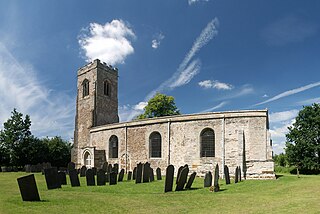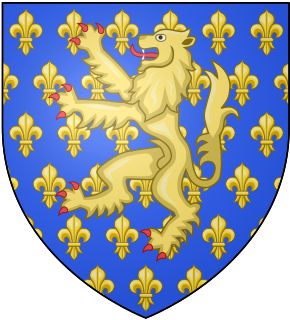
Market Bosworth is a market town and civil parish in western Leicestershire, England. At the 2001 Census, it had a population of 1,906, increasing to 2,097 at the 2011 census. It is most famously near to the site of the decisive final battle of the Wars of the Roses.

Baron Cottesloe, of Swanbourne and Hardwick in the County of Buckingham, is a title in the Peerage of the United Kingdom. It was created on 2 March 1874 for the Conservative politician and former Chief Secretary for Ireland, Sir Thomas Fremantle, 1st Baronet (1798–1890). He was the son of Admiral Sir Thomas Fremantle (1765–1819). Lord Cottesloe had already been created a Baronet, of Swanbourne in the County of Buckingham, on 14 August 1821, chiefly in recognition of his father's services, and with remainder to the latter's heirs. His father Sir Thomas Fremantle was created Baron Fremantle, of the Austrian Empire, which Lord Cottesloe inherited in 1819 with the death of his father. Subsequently, in 1822 he was given a Royal licence, which authorized him and his successors to use the title in Britain. However, a warrant issued on 27 April 1932 withdrew all the royal licences, only allowing the use of the title to the then current holders, their heir and their heir's heir. The fifth baron was the last holder being allowed to use the Austrian title in the United Kingdom.

Earl of Stamford was a title in the Peerage of England. It was created in 1628 for Henry Grey, 2nd Baron Grey of Groby. This Grey family descended through Lord John Grey, of Pirgo, Essex, younger son of Thomas Grey, 2nd Marquess of Dorset, and younger brother of Henry Grey, 1st Duke of Suffolk ; Suffolk was executed for treason in 1554 forfeiting his titles.
There has been a Lord Lieutenant of Buckinghamshire almost continuously since the position was created by King Henry VIII in 1535. The only exception to this was the English Civil War and English Interregnum between 1643 and 1660 when there was no king to support the Lieutenancy. The following list consists of all known holders of the position: earlier records have been lost and so a complete list is not possible. Since 1702, all Lord Lieutenants have also been Custos Rotulorum of Buckinghamshire.

Thomas Francis Fremantle, 1st Baron Cottesloe, 2nd Baron Fremantle,, known as Sir Thomas Fremantle, Bt, between 1821 and 1874, was a British Tory politician.

Thomas Francis Fremantle, 3rd Baron Cottesloe, 4th Baron Fremantle was a British peer and sportsman who competed in the shooting event at the 1908 Summer Olympics.
The Gough-Calthorpe family is descended from ancient and notable families who both held lands in the area around Birmingham, England.
This is a list of Sheriffs and High Sheriffs of Leicestershire, United Kingdom. The Sheriff is the oldest secular office under the Crown. Formerly the High Sheriff was the principal law enforcement officer in the county but over the centuries most of the responsibilities associated with the post have been transferred elsewhere or are now defunct, so that its functions are now largely ceremonial. Under the provisions of the Local Government Act 1972, on 1 April 1974 the office previously known as Sheriff was retitled High Sheriff. The High Sheriff changes every March.

Wistow is a deserted medieval village in the English county of Leicestershire, and lies seven miles south-east of the city of Leicester in the valley of the River Sence. Since 1936 it has included most of the former civil parish of Newton Harcourt which is a chapelry of Wistow. The population of the civil parish at the 2011 census was 256.

The Dixie Baronetcy was created in the Baronetage of England at the time of the Restoration of the Monarchy in 1660 for Sir Wolstan Dixie (1602–1682), a supporter of King Charles I during the English Civil War and afterwards. He was descended from a brother of Sir Wolstan Dixie, the sixteenth century Lord Mayor of London who founded the Dixie Professorship of Ecclesiastical History in the University of Cambridge. Their home was Bosworth Hall near Market Bosworth in Leicestershire. The title became extinct with the death of the thirteenth Baronet, another Sir Wolstan Dixie, in 1975.

There have been four baronetcies created for members of the ancient House of Beaumont, all in the Baronetage of England. All four creations are extinct or dormant.
Three baronetcies were created for different families bearing the name of Halford, but related to one another. The first baronetcy was created in 1641 for Richard Halford in the Baronetage of England. It became extinct in 1780 with the death of the seventh and last baronet. The second baronetcy was created in 1706, also in the Baronetage of England, but became extinct in 1720 in the second generation. The third and last baronetcy was created in 1809 in the Baronetage of the United Kingdom for a prominent physician descended maternally from the fifth Baronet of the previous creation. It too became extinct with the death of the fourth Baronet in 1897.

Sir Henry Halford, 1st Baronet, GCH, born Henry Vaughan, was president of the Royal College of Physicians for 24 years. As the royal and society physician, he was physician extraordinary to King George III from 1793 to 1820, then as physician in ordinary to his three successors – George IV, William IV and the young Victoria. He also served other members of the Royal Family until his death.

Sir George Orby Wombwell, 4th Baronet was a British baronet.

Stockerston Hall is a late-18th-century English country house in Leicestershire, near the town of Uppingham, Rutland. It is a Grade II listed building.
Sir Henry Halford, 2nd Baronet was an English Tory and later Conservative politician who sat in the House of Commons from 1832 to 1857.
Sir John Vaughan PC was an English judge.
Stoughton Grange was a country house in the parish of Stoughton in Leicestershire and the family seat of the Farnham and Beaumont family. The house dated back to 15th century but was demolished in 1926, after being a successful family home for over five hundred years.
Sir Henry St John Halford, 3rd Baronet was an English landowner and expert rifleman.
Sir Timothy Gerald Martin Brooks, KCVO (1929–2014) was an English landowner, farmer, politician and public servant.












